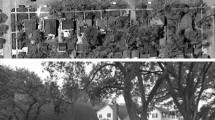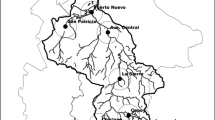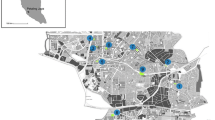Abstract
Ecological impacts associated with nature-based recreation and tourism can compromise park and protected area goals if left unrestricted. Protected area agencies are increasingly incorporating indicator-based management frameworks into their management plans to address visitor impacts. Development of indicators requires empirical evaluation of indicator measures and examining their ecological and social relevance. This study addresses the development of the informal trail indicator in Yosemite National Park by spatially characterizing visitor use in open landscapes and integrating use patterns with informal trail condition data to examine their spatial association. Informal trail and visitor use data were collected concurrently during July and August of 2011 in three, high-use meadows of Yosemite Valley. Visitor use was clustered at statistically significant levels in all three study meadows. Spatial data integration found no statistically significant differences between use patterns and trail condition class. However, statistically significant differences were found between the distance visitors were observed from informal trails and visitor activity type with active activities occurring closer to trail corridors. Gender was also found to be significant with male visitors observed further from trail corridors. Results highlight the utility of integrated spatial analysis in supporting indicator-based monitoring and informing management of open landscapes. Additional variables for future analysis and methodological improvements are discussed.




Similar content being viewed by others
References
Alessa L, Kliskey A, Brown G (2008) Social-ecological hotspots mapping: a spatial approach for identifying coupled social-ecological space. Landsc Urban Plan 85:27–39
Arnberger A, Haider W, Bradenburg C (2005) Evaluating visitor-monitoring techniques: a comparison of counting and video observation data. Environ Manag 36:317–327
Bacon J, Roche J, Elliot C, Nicolas N (2006) VERP: putting principles into practice in Yosemite National Park. George Wright Forum 23:73–83
Ballenger L, Wiklin K, Acree L, Baccei J, Whittaker T, Babich E (2011) 2010 Assessment of meadows in the Merced River Corridor, Yosemite National Park. http://www.nps.gov/yose/parkmgmt/upload/MRP-Meadows_Report_20120424.pdf (National Park Service Web site). Accessed 6 Oct 2012
Balmford A, Beresford J, Green J, Naidoo R, Walpole M, Manica A (2009) A global perspective on trends in nature-based tourism. PLoS Biol 7:1–6
Bayfield NG (1971) A simple method for detecting variations in walker pressure laterally across paths. J Appl Ecol 8:533–535
Bayfield NG (1973) Use and deterioration of some Scottish hill paths. J Appl Ecol 10:635–644
Beeco JA, Brown G (2013) Integrating space, spatial tools, and spatial analysis into the human dimensions of parks and outdoor recreation. Appl Geogr 28:76–85
Belnap J (1998) Choosing indicators of natural resource condition: a case study in Arches National Park, Utah, USA. Environ Manag 22:635–642
Bryan RB (1977) The influence of soil properties on degradation of mountain hiking trails at Grövelsjön. Geogr Ann Ser A Phys Geogr 59:49–65
Buckley R (2003) Ecological indicators of tourist impacts in parks. J Ecotourism 2:54–66
Buckley R (ed) (2004) Environmental impacts of ecotourism. CABI Publishing, Wallingford
Burden RF, Randerson PF (1972) Quantitative studies of the effects of human trampling on vegetation as an aid to the management of semi-natural areas. J Appl Ecol 9:439–457
Cai X, Wu Z, Cheng J (2013) Using kernel density estimation to assess the spatial pattern of road density and its impact on landscape fragmentation. Int J Geogr Inf Sci 27:222–230
Cessford G, Muhar A (2003) Monitoring options for visitor numbers in national parks and natural areas. J Nat Conserv 11:240–250
Cordell HK (2008) The latest on trends in nature-based outdoor recreation. For Hist 10:4–10
Cosco NG, Moore RC, Islam MZ (2010) Behavior mapping: a method for linking preschool physical activity and outdoor design. Med Sci Sports Exerc 42:513–519
Dale D, Weaver T (1974) Trampling effects on vegetation of the trail corridors of north Rocky Mountain forests. J Appl Ecol 11:767–772
D’Antonio A, Monz CA, Lawson S, Newman P (2010) GPS-based measurements of backcountry visitors in parks and protected areas: examples of methods and applications from three case studies. J Park Recreat Adm 28:42–60
Foin TC, Garton EO, Bowen CW, Everingham JM, Schultz RO, Holton B (1977) Quantitative studies of visitor impacts on environments of Yosemite National Park, California, and their implications for park management policy. J Environ Manag 5:1–22
Forman RT (1995) Land mosaics. Cambridge University Press, New York
Hadwen WL, Hill W, Pickering CM (2007) Icons under threat: why monitoring visitors and their ecological impacts in protected areas matters. Ecol Manag Restor 8:177–181
Hallo JC, Beeco JA, Goetcheus C, McGee J, McGehee NG, Norman WC (2012) GPS as a method for assessing spatial and temporal use distributions of nature-based tourists. J Travel Res 51:591–606
Hammitt WE, Cole DN (1998) Wildland recreation: ecology and management, 2nd edn. Wiley, New York
Helbing D, Keltsch J, Molnar P (1997) Modeling the evolution of human trail systems. Nature 388:47–50
Hockett K, Clark A, Leung Y-F, Marion JL, Park L (2010) Deterring off-trail hiking in protected natural areas: evaluating options with surveys and unobtrusive observation. Final Management Report. USGS Patuxent Wildlife Research Center, Virginia Tech Field Unit, Blacksburg
Johnson DR, Swearingen TC (1992) The effectiveness of selected trailside sign texts in deterring off-trail hiking at Paradise Meadow, Mount Rainier National Park. In: Christensen HH, Johnson DR., Brookes MH (tech coords) Vandalism: research, prevention and social policy. Gen. Tech. Report PNW-GTR-293. USDA Forest Service, Pacific Northwest Research Station, Portland, pp 103–120
Keirle I, Stephens M (2004) Do walkers stay on footpaths? An observational study of Cwm Idwal in the Snowdonia National Park. Countrys Recreat 12:7–9
Kim M, Daigle J (2011) Detecting vegetation cover change on the summit of Cadillac Mountain using multi-temporal remote sensing datasets: 1979, 2001, and 2007. Environ Monit Assess 180:63–75
Kinney JW, Clary WP (1998) Time-lapse photography to monitor riparian meadow use. Research Note RMRS-RN-5. USDA Forest Service, Rocky Mountain Research Station, Fort Collins
Lehvavirta S (1999) Structural elements as barriers against wear in urban woodlands. Urban Ecosyst 4:45–56
Leslie TF, Kronenfeld BJ (2011) The collation quotient: a new measure of spatial association between categorical subsets of points. Geogr Anal 43:306–326
Leung Y-F, Marion JL (1996) Trail degradation as influenced by environmental factors: a state-of-the-knowledge review. J Soil Water Conserv 51:130–136
Leung Y-F, Neller RJ (1995) Trail degradation along the Pat Sin Range: an example of environmental geomorphology. Hong Kong Geol 1:79–87
Leung Y-F, Shaw N, Johnson K, Duhaime R (2002) More than a database: integrating GIS data with the Boston Harbor Islands carrying capacity study. George Wright Forum 19:69–78
Leung Y-F, Bigsby K, Kollar C (2011a) Developing methods for integrated analysis of meadow condition and informal trail data in Yosemite National Park. Technical report submitted to USDI National Park Service, Yosemite National Park
Leung Y-F, Newburger T, Jones M, Kuhn B, Woiderski B (2011b) Developing a monitoring protocol for visitor-created informal trails in Yosemite National Park. Environ Manag 47:93–106
Liddle MJ (1997) Recreation ecology: the ecological impact of outdoor recreation and ecotourism. Chapman & Hall, London
Littlejohn MA, Meldrum BH, Hollenhorst SJ (2005) Yosemite National Park visitor study, summer 2005. Visitor Services Project Report 168. http://psu.uidaho.edu/files/vsp/reports/168_YOSE_rept.pdf. Accessed 8 Mar 2013
Manning RE (2007) Parks and carrying capacity: commons without tragedy. Island Press, Washington, DC
Manning RE (2011) Studies in outdoor recreation: search and research for satisfaction, 3rd edn. Oregon State University Press, Corvallis
Marion JL, Leung Y-F (2011) Indicators and protocols for monitoring impacts of formal and informal trails in protected areas. J Tour Leis Stud 17:215–236
Marion JL, Leung Y-F, Nepal SK (2006) Monitoring trail conditions: new methodological considerations. George Wright Forum 23:36–49
McCool SF, Clark RN, Stankey GH (2007) An assessment of frameworks useful for public land recreation planning. Gen. Tech. Rep. PNW-GTR-705. USDA Forest Service, Pacific Northwest Research Station, Portland
McDonald JH (2009) Handbook of biological statistics, 2nd edn. Sparky House Publishing, Baltimore
McKenzie TL (2010) Seeing is believing: observing physical activity and its contexts. Res Q Exerc Sport 81:113–122
McKenzie TL, Cohen DA (2006) SOPARC (system for observing play and recreation in communities): description and procedures manual. http://www.activelivingresearch.org/files/SOPARC_Protocols.pdf. Accessed 8 Mar 2013
McKenzie TL, Cohen DA, Sehgal A, Williamson S, Golinelli D (2006) System for observing play and recreation in communities (SOPARC): reliability and feasibility measures. J Phys Act Health 3:S208–S222
Monz C, Leung Y-F (2006) Meaningful measures: developing indicators of visitor impact in the National Park Service Inventory and Monitoring program. George Wright Forum 23:17–27
Moore RC, Cosco NG (2010) Using behaviour mapping to investigate healthy outdoor environments for children and families. In: Ward TC, Bell S (eds) Innovative approaches to research excellence in landscape and health. Taylor & Francis, London, pp 36–67
Moore SA, Smith AJ, Newsome DN (2003) Environmental performance reporting for natural area tourism: contributions by visitor impact management frameworks and their indicators. J Sustain Tour 11:348–375
Moskal LM, Halabisky M (2010) Analysis of social trails in Mt. Rainier National Park: a pilot study. Unpublished report. http://www.cfr.washington.edu/research.cesu/reports/J8W07090020_final_report.pdf. Accessed 12 Sept 2012
Muhar A, Arnberger A, Brandenburg C (2002) Methods for visitor monitoring in recreational and protected areas: an overview. In: Arnberger A, Brandenburg C, Muhar A (eds) Proceedings of the first conference on monitoring and management of visitor flows in recreational and protected areas. University of Natural Resources and Applied Life Sciences, Vienna, pp 1–6
Newburger T, Pettebone D, Roche J, Meldrum B, Middleton J, Meyer J, Seher T, Woiderski B (2011) Visitor use and impacts monitoring program: 2010 annual report. Yosemite National Park. Unpublished report
Newsome D, Moore SA, Dowling RK (2012) Natural area tourism: ecology, impacts and management, 2nd edn. Channel View Books, Clevedon
NPS (2007) Vegetation changes in Yosemite Valley: maintaining meadows. Occasional Paper no. 5. http://www.cr.nps.gov/history/online_books/science/op5/sec6.htm. Accessed 5 Jan 2012
NPS (2010) Visitor use and impacts monitoring: 2010 field monitoring guide. USDI National Park Service, Yosemite National Park, Yosemite
NPS (2012) NPS public use statistics office. http://www.nature.nps.gov/statistics. Accessed 23 Jan 2012
O’Sullivan D, Unwin DJ (2010) Geographic information analysis, 2nd edn. Wiley, New York
Orellana D, Bregt AK, Ligtenberg A, Wachowicz M (2012) Exploring visitor movement patterns in natural recreation areas. Tour Manag 33:672–682
Ostermann FO (2010) Digital representation of park use and visual analysis of visitor activities. Comput Environ Urban Syst 34:452–464
Park LO, Manning RE, Marion JL, Lawson SR, Jacobi C (2008) Managing visitor impacts in parks: a multi-method study of effectiveness of alternative management practices. J Park Recreat Adm 26:97–121
Pearce-Higgins JW, Yalden DW (1997) The effects of resurfacing the Pennine Way on recreational use of blanket bog in the Peak District National Park, England. Biol Conserv 83:337–343
Reed JA, McKenzie TL, Hagen S, Harring H (2007) Using direct observation methodology to measure trail use. Int Counc Health Phys Educ Recreat Sport Dance 43:33–39
Rochefort RM, Gibbons ST (1993) Impact monitoring and restoration in Mount Rainier NP. Park Sci 13:29–30
Rochefort RM, Swinney DD (2000) Human impact surveys in Mount Rainier National Park: past, present, and future. In: Cole DN, McCool SF, Borrie WT, O’Loughlin J (eds) Wilderness science in a time of change conference, vol 5: Wilderness ecosystems, threats, and management. Proceedings RMRS-P-15-VOL-5. USDA Forest Service, Rocky Mountain Research Station, Ogden, UT, pp 165–171
Root JD, Knapik LJ (1972) Trail conditions along a portion of the Great Divide Trail Route, Alberta and British Columbia Rocky Mountains. Report 72-5. Research Council of Alberta, Edmonton, Alberta
Sasidharan V, McKenzie TL (2011) Observing physical activity and recreation in natural areas (SOPARNA). Res Q Exerc Sport 82(1):A-6 (Abstract)
Sutter RD, Benjamin SE, Murdock N, Teague B (1993) Monitoring the effectiveness of a boardwalk at protecting low heath bald in southern Appalachians. Nat Areas J 13:250–255
Thurston E, Reader RJ (2001) Impacts of experimentally applied mountain biking and hiking on vegetation and soil of a deciduous forest. Environ Manag 27:397–409
Turner R, LaPage W (2002) Visitor behavior and resource impacts at Cadillac Mountain, Acadia National Park. In: Todd S (ed) Proceedings of the 2001 northeastern recreation research symposium. Gen. Tech. Rep. NE-289. USDA Forest Service, Northeastern Research Station, Newtown Square, pp 175–179
UNEP-WCMC (2008) State of the world’s protected areas: an annual review of global conservation progress. UNEP-WCMC, Cambridge
Unwin DJ (1996) GIS, spatial analysis and spatial statistics. Prog Hum Geogr 20:540–551
Webb EJ, Campbell DT, Schwartz RD, Sechrest L (2000) Unobtrusive measures, rev. ed. Sage Publications, Thousand Oaks
Wilson JB, Agnew ADQ (1992) Positive-feedback switches in plant communities. Adv Ecol Res 33:263–336
Wilson JB, King WM (1995) Human-mediated vegetation switches as processes in landscape ecology. Landsc Ecol 10:191–196
Wimpey J, Marion JL (2011) A spatial exploration of informal trail networks within Great Falls Park, VA. J Environ Manag 92:1012–1022
Wing MG, Eklund A, Kellog LD (2005) Consumer-grade global positioning system (GPS) accuracy and reliability. J For 103:169–173
Wood KT, Lawson SR, Marion JL (2006) Assessing recreation impacts to cliffs in Shenandoah National Park: integrating visitor observation with trail and recreation site measurements. J Park Recreat Adm 24:86–110
Yalden PE, Yalden DW (1988) The level of recreational pressure on blanket bog in the Peak District National Park, England. Biol Conserv 44:213–227
Acknowledgments
This Project was made possible by funding from the Department of Parks, Recreation & Tourism Management at North Carolina State University. The authors would like to thank T. Newburger and B. Woiderski of the Resources Management and Science Division at Yosemite National Park for their logistical support and guidance on this Project. Additional thanks are also extended to the volunteers who assisted in collecting visitor use data.
Author information
Authors and Affiliations
Corresponding author
Rights and permissions
About this article
Cite this article
Walden-Schreiner, C., Leung, YF. Spatially Characterizing Visitor Use and Its Association with Informal Trails in Yosemite Valley Meadows. Environmental Management 52, 163–178 (2013). https://doi.org/10.1007/s00267-013-0066-0
Received:
Accepted:
Published:
Issue Date:
DOI: https://doi.org/10.1007/s00267-013-0066-0




